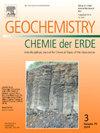The origin and evolution of REE enrichment in the Dashigou Mo-REE deposit, China: Insights from mineralogy, geochemistry and C-O-Sr-Nd isotope systematics
IF 2.9
3区 地球科学
Q2 GEOCHEMISTRY & GEOPHYSICS
引用次数: 0
Abstract
The Dashigou deposit is a carbonatite-hosted REE-Mo deposit within the Huanglonpu metallogenic district of the Qinling belt in central China. This work aims to study origin of heavy REE enrichment using the mineralogy, mineral chemistry and C-O-Sr-Nd isotope signatures of the carbonates. Two stages of REE mineralization are distinguished, along with two generations of calcite (Cal-I and Cal-II). Monazite, bastnäsite, and xenotime are the primary REE minerals at the early carbonatite stage, with Cal-I having a high REE content of 1257–1745 ppm. The late-stage veins are characterized by abundant REE minerals, sulfates, and sulfides, including monazite, allanite, betafite group minerals, celestine, baryte, molybdenite, pyrite and sphalerite. Early magmatic minerals show signs of secondary replacement and metasomatism, with particularly abundant hydrothermal calcite and allanite. This indicates that REEs were remobilized hydrothermally into a secondary REE-rich mineral assemblage, possibly in large part through the dissolution of early REE-rich calcite. This is also supported by Cal-II having lower REE contents compared to Cal![]() I. In situ trace element compositions display a flat REE pattern with HREE enrichment compared to bulk rock compositions. The Cal-I contains a higher HREE content of 768–1124 ppm with (La/Lu) N ratios of 0.84–1.37, making it the dominant mineral that controls the HREE budget in Dashigou. The C
I. In situ trace element compositions display a flat REE pattern with HREE enrichment compared to bulk rock compositions. The Cal-I contains a higher HREE content of 768–1124 ppm with (La/Lu) N ratios of 0.84–1.37, making it the dominant mineral that controls the HREE budget in Dashigou. The C![]() O isotopic compositions of calcite have a narrow range from −7.27 to −6.65 ‰, and from 9.10 to 9.28 ‰, respectively, falling within the primary igneous carbonatite field. This indicates it is mantle-derived. In situ Sr isotopic values of calcite vary between 0.70502 and 0.70572, which are comparable to bulk rock values for the Huanglongpu carbonatites. Monazite grains from the Dashigou carbonatites have 143Nd/144Nd ratios between 0.51190 and 0.51205, and their εNd (t) values vary from −10.0 to −7.1, with an average value of −8.5. Our data suggests that both enriched mantle and crustal components contributed to the formation of REE-Mo mineralization in the Dashigou carbonatites.
O isotopic compositions of calcite have a narrow range from −7.27 to −6.65 ‰, and from 9.10 to 9.28 ‰, respectively, falling within the primary igneous carbonatite field. This indicates it is mantle-derived. In situ Sr isotopic values of calcite vary between 0.70502 and 0.70572, which are comparable to bulk rock values for the Huanglongpu carbonatites. Monazite grains from the Dashigou carbonatites have 143Nd/144Nd ratios between 0.51190 and 0.51205, and their εNd (t) values vary from −10.0 to −7.1, with an average value of −8.5. Our data suggests that both enriched mantle and crustal components contributed to the formation of REE-Mo mineralization in the Dashigou carbonatites.
大石沟钼矿床稀土元素富集成因及演化:矿物学、地球化学和C-O-Sr-Nd同位素系统的启示
大石沟矿床是秦岭带黄龙堡成矿区内的碳酸盐岩型稀土钼矿床。本文旨在利用碳酸盐的矿物学、矿物化学和C-O-Sr-Nd同位素特征研究重稀土富集的成因。稀土矿化分为两个阶段,伴随有两代方解石(Cal-I和Cal-II)。碳酸盐岩早期主要REE矿物为独居石、bastnäsite和xenotime, cal - 1的REE含量较高,为1257 ~ 1745 ppm。晚期脉体以丰富的稀土矿物、硫酸盐和硫化物为特征,包括独居石、allanite、betafite族矿物、天青石、重晶石、辉钼矿、黄铁矿和闪锌矿。早期岩浆矿物具有次生替代和交代作用,热液方解石和allanite尤为丰富。这表明稀土元素在水热作用下被重新活化,形成了次生的富稀土矿物组合,可能主要是通过早期富稀土方解石的溶蚀作用。与CalI相比,Cal-II具有更低的REE含量,这也支持了这一点。原位微量元素组成呈现出稀土元素富集的扁平模式。cal - 1的HREE含量较高,为768 ~ 1124 ppm, La/Lu / N比值为0.84 ~ 1.37,是控制大石沟地区HREE收支的主导矿物。方解石CO同位素组成范围较窄,分别为- 7.27 ~ - 6.65‰和9.10 ~ 9.28‰,属于原生火成岩碳酸盐岩场。这表明它是地幔衍生的。方解石的原位Sr同位素值在0.70502 ~ 0.70572之间,与黄龙堡碳酸盐岩的体岩值相当。大石沟碳酸盐岩独居石颗粒的143Nd/144Nd比值在0.51190 ~ 0.51205之间,εNd (t)值在- 10.0 ~ - 7.1之间,平均值为- 8.5。研究表明,大石沟碳酸盐岩中稀土钼矿化的形成与地幔和地壳组分的富集有关。
本文章由计算机程序翻译,如有差异,请以英文原文为准。
求助全文
约1分钟内获得全文
求助全文
来源期刊

Chemie Der Erde-Geochemistry
地学-地球化学与地球物理
CiteScore
7.10
自引率
0.00%
发文量
40
审稿时长
3.0 months
期刊介绍:
GEOCHEMISTRY was founded as Chemie der Erde 1914 in Jena, and, hence, is one of the oldest journals for geochemistry-related topics.
GEOCHEMISTRY (formerly Chemie der Erde / Geochemistry) publishes original research papers, short communications, reviews of selected topics, and high-class invited review articles addressed at broad geosciences audience. Publications dealing with interdisciplinary questions are particularly welcome. Young scientists are especially encouraged to submit their work. Contributions will be published exclusively in English. The journal, through very personalized consultation and its worldwide distribution, offers entry into the world of international scientific communication, and promotes interdisciplinary discussion on chemical problems in a broad spectrum of geosciences.
The following topics are covered by the expertise of the members of the editorial board (see below):
-cosmochemistry, meteoritics-
igneous, metamorphic, and sedimentary petrology-
volcanology-
low & high temperature geochemistry-
experimental - theoretical - field related studies-
mineralogy - crystallography-
environmental geosciences-
archaeometry
 求助内容:
求助内容: 应助结果提醒方式:
应助结果提醒方式:


